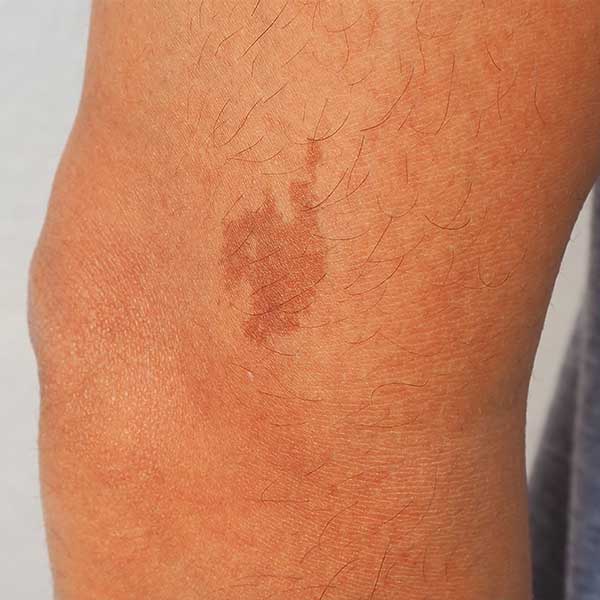
Neurofibromatosis
Neurofibromatosis (NF) is a complex and often misunderstood genetic disorder that affects the nervous system. It presents in various forms, with two primary types: Neurofibromatosis type 1 (NF1) and Neurofibromatosis type 2 (NF2). NF can manifest differently from person to person, making it essential to grasp the fundamentals of this condition.
Types of Neurofibromatosis
Neurofibromatosis Type 1 (NF1):
NF1, also known as von Recklinghausen disease, is the more common type, affecting approximately one in 3,000 people worldwide. It is caused by mutations in the NF1 gene, leading to the growth of non-cancerous tumors called neurofibromas on or under the skin, along nerves, and sometimes in other parts of the body. These tumors can cause visible bumps on the skin and may lead to various complications, including skeletal abnormalities, optic nerve glioma, and other neurological issues. Additionally, some individuals with NF1 may experience learning difficulties or develop other non-tumor-related health problems.
Neurofibromatosis Type 2 (NF2):
NF2 is relatively rare, affecting approximately one in 25,000 people globally. It results from mutations in the NF2 gene, leading to the development of non-cancerous tumors called vestibular schwannomas, commonly known as acoustic neuromas. These tumors form on the nerves responsible for balance and hearing, which can lead to hearing loss, balance problems and, in some cases, affect other cranial nerves. NF2 can also cause other nervous system tumors, such as meningiomas or ependymomas, further complicating the condition.

Recognizing the Symptoms
Neurofibromatosis (NF) is a complex genetic disorder that can manifest in various ways, making early recognition of symptoms crucial for timely diagnosis and management. While the symptoms can differ depending on the type and severity of NF, certain key indicators are common to both Neurofibromatosis type 1 (NF1) and Neurofibromatosis type 2 (NF2). Understanding these symptoms is essential to facilitate early intervention and improve overall health outcomes.
Neurofibromatosis Type 1 (NF1) Symptoms:
Neurofibromas: NF1 is characterized by the development of non-cancerous tumors called neurofibromas, which grow on or under the skin, along nerves, and in various organs. These tumors may appear as small, soft bumps on or under the skin.
Café-au-lait Spots: These are pigmented birthmarks that appear as light brown patches on the skin. They are a hallmark sign of NF1 and may be present at birth or develop in early childhood.
Freckling in Armpits or Groin: Specific areas of the body, such as the armpits or groin, may exhibit clusters of freckles that are typically larger and darker than regular freckles.
Optic Nerve Glioma: Children with NF1 may develop tumors on the optic nerve, which can lead to vision problems and, in some cases, vision loss.
Skeletal Abnormalities: NF1 can cause skeletal issues, such as scoliosis (curvature of the spine) or bowing of the long bones.
Learning Difficulties: Some individuals with NF1 may experience learning disabilities or have attention deficit hyperactivity disorder (ADHD).
Neurofibromatosis Type 2 (NF2) Symptoms:
Vestibular Schwannomas (Acoustic Neuromas): NF2 is primarily associated with the development of non-cancerous tumors on the vestibular nerves, which control balance and hearing. These tumors can lead to hearing loss, ringing in the ears (tinnitus), and problems with balance.
Other Nervous System Tumors: In addition to vestibular schwannomas, individuals with NF2 may develop other nervous system tumors, such as meningiomas (tumors on the membranes surrounding the brain and spinal cord) or ependymomas (tumors arising from the lining of the brain or spinal cord).
It’s important to note that not all individuals with NF will experience all of these symptoms, and the severity can vary significantly from person to person. Some individuals may have very mild symptoms, while others may experience more pronounced complications.

Neurofibromatosis Causes
Neurofibromatosis (NF) is a complex genetic disorder caused by mutations in specific genes that regulate cell growth and division in the nervous system. While the exact triggers for these mutations remain an active area of research, understanding the underlying causes of NF can shed light on its development and impact on the affected individual.
Neurofibromatosis Type 1 (NF1) Causes:
NF1 is primarily caused by mutations in the NF1 gene located on chromosome 17. This gene produces a protein called neurofibromin, which plays a critical role in controlling cell growth. The mutations in the NF1 gene lead to a reduction or loss of functional neurofibromin, resulting in abnormal cell growth and the formation of non-cancerous tumors called neurofibromas. These tumors can develop in various tissues of the body, including the skin and nerves.
Neurofibromatosis Type 2 (NF2) Causes:
NF2, on the other hand, is caused by mutations in the NF2 gene situated on chromosome 22. The NF2 gene encodes a protein called merlin (also known as schwannomin), which helps regulate cell growth and plays a critical role in maintaining the integrity of Schwann cells that support nerve cells. When mutations occur in the NF2 gene, merlin function is impaired, leading to the growth of non-cancerous tumors called vestibular schwannomas (acoustic neuromas) on the nerves responsible for balance and hearing. In NF2, additional nervous system tumors, such as meningiomas or ependymomas, can also develop.
Genetic Inheritance:
Both types of NF are inherited conditions, meaning that the mutations in the respective genes are present at birth and can be passed down from one generation to the next. However, in some cases, NF can also arise spontaneously without any family history of the condition due to random genetic mutations.

Treatment Options for Neurofibromatosis
Neurofibromatosis (NF) is a challenging condition but advances in medical science have brought about promising treatment options to help manage its symptoms and improve the quality of life for those affected. While there is no cure for NF, a comprehensive and personalized treatment plan can make a significant difference in symptom management and overall well-being.
Treatment options for Neurofibromatosis primarily depend on the type and severity of the condition:
Neurofibromatosis Type 1 (NF1) Treatment:
Observation and Monitoring: In many cases, neurofibromas in NF1 are non-cancerous and may not require immediate intervention. Regular monitoring and check-ups are essential to assess tumor growth and detect any potential complications.
Surgical Removal: When neurofibromas cause significant discomfort, functional impairment, or compression of vital structures, surgical removal may be recommended. Our skilled surgical team specializes in minimally invasive techniques to optimize patient outcomes.
Medication: Certain medications, such as pain relievers or those targeting specific tumor growth pathways, may be prescribed to alleviate symptoms and slow tumor growth.
Management of Associated Conditions: Since NF1 can be associated with other health concerns like scoliosis or learning disabilities, a multidisciplinary approach involving specialists from various fields is essential for comprehensive care.
Neurofibromatosis Type 2 (NF2) Treatment:
Surgical Intervention: In NF2, surgical removal of vestibular schwannomas (acoustic neuromas) is often necessary when these tumors cause hearing loss, balance issues, or pressure on nearby structures.
Radiation Therapy: In some cases, stereotactic radiosurgery or conventional radiation therapy may be considered to treat tumors that are difficult to access surgically.
Auditory Rehabilitation: Since hearing loss is a common symptom in NF2, auditory rehabilitation, including hearing aids or cochlear implants, can significantly improve the quality of life for patients.
Tumor Management: Regular monitoring of other nervous system tumors, such as meningiomas or ependymomas, is essential to detect any changes early and initiate appropriate treatment.
Genetic Counseling:
Genetic counseling is a vital component of NF treatment, especially for individuals and families with a history of the condition. Genetic counselors offer valuable insight into the genetic inheritance of NF and help individuals make informed decisions about family planning.
We understand that each person’s journey with NF is unique, and we tailor treatment plans accordingly. Our commitment to cutting-edge research and patient-centered care ensures that you receive the best possible treatment options for your specific needs.


